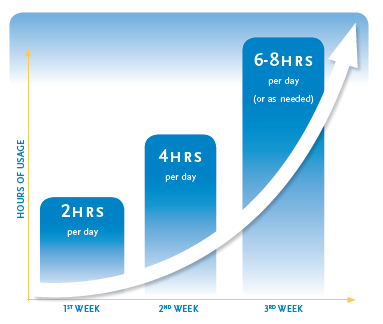Ask questions, find solutions, and get on with life’s big adventure! This section takes you through a few of the more frequently-asked questions from people experiencing osteoarthritis and the pain that accompanies this condition.
Treatment: Non-surgical options
Although no cure currently exists for osteoarthritis (OA) several non-surgical treatment options are available to help alleviate the pain and allow you to get on with your life.
Is bracing an option for osteoarthritis?
There are certain braces available that apply corrective forces to the affected joint where the arthritis is at its worst. In the past, these tended to be bulky devices, that were uncomfortable to wear. But now there are lightweight, easy-to-use braces that fit discreetly under clothing and are clinically proven to reduce osteoarthritis pain. Unloader One and Unloader One Lite are specifically designed for knee OA and clinically proven to help with the pain.
Unloader Hip is now also available for individuals who have been diagnosed with hip osteoarthritis. Unloader Hip braces works similarly to the Unloader knee braces, by applying corrective forces on the affected area of the hip joint and improves quality of life.
Bracing can also be used in conjunction with other forms of treatment, such as exercise and weight loss programs, injections and physical therapy, for better outcomes.
Can physical or occupational therapy help?
If your doctor thinks that massages and/or exercises may help soothe your osteoarthritis, they may refer you to a physical therapist, who will work with you on an exercise program tailored to your needs. If you would benefit from things like a higher chair or adjustable toilet seat, to avoid bending your knees or at your waist significantly, or to give you a better angle to stand up, you may find it useful to talk to an occupational therapist, who will know all about special devices to make home and work life easier and less painful.
What about medication and injections?
Medication is used primarily to control the symptoms of knee and hip OA, especially the pain. There are a number of prescription drugs and common over-the-counter-medicines that can help. These include aspirin-free pain relievers (paracetamol), anti-inflammatory drugs and creams (Ibuprofen, Naproxen, Diclofenac), corticosteroids (steroids may help control inflammation) and sleeping pills.
Pain can gradually get worse as the OA progresses, so sometimes stronger drugs are prescribed. However, the long-term nature of OA means that taking stronger medication over a long period of time may lead to unwanted side-effects, something that needs consideration. Injections of hyaluronic acid (found naturally in healthy joints) can also be used to provide temporary relief, while anesthetics with an anti-inflammatory ingredient (commonly cortisone) may help to relieve the pain by numbing the knee or hip. These kinds of injections are well-established treatments, but the results can vary from patient to patient.
Should I exercise and manage my weight?
If you can lose any surplus body weight, you will help to ease the pain because the stress on your joints, as well as inflammation, can be reduced. Regular exercise can help. It can also improve your strength and joint flexibility, which will help to increase movement and potentially reduce the pain. It's important to include joint and muscle exercises, but AVOID high-impact activities that increase the load on your joints as much as possible - climbing lots of stairs for example. Avoid activities that involve twisting or rapid stop/start movements. Try not to kneel down too much, or lift heavy objects. Don't sit down too often on low chairs or sofas. And if you do have to do any of these things, remember to take a break and give your joints a rest.
Braces: Why and how to use
An Unloader brace that has been correctly fit by a practitioner is easy to maintain, and when used properly can alleviate pain caused by knee and hip osteoarthritis (OA).
How many hours per day should I wear my Unloader brace initially?
It is recommended that you build up the time spent wearing the brace gradually during the first three weeks. In the first week, two hours per day is the recommended length of time. In the second week, you can start to wear your brace for up to four hours per day. By the third week, you can wear your brace for six to eight hours per day, or as needed.
Your practitioner can explain more when fitting the Unloader, and you will receive a patient guide to take home with you.
If you've been fitted with an Unloader One knee brace, please refer to the online patient guide for additional information.

Going forward, how long should I use my Unloader brace for?
This will depend on many factors. Some individuals wear their brace to remain active and delay the need for surgery as long as possible, while others wear it to become healthier surgical candidates. Talk to your doctor about your aspirations and goals for the use of your Unloader brace.
How do Unloader braces work?
Unloader braces unload the affected, painful side of the knee using a 3-Point Leverage System and are proven to reduce pain and improve function. Some patients also report a reduction in pain medication. The Unloader Hip brace is a unique approach to hip OA and proven to improve activities of daily living. Unloading can help to relieve the pain, allowing you to walk normally and more frequently.
Can I work out in an Unloader brace?
Yes, the goal of an Unloader brace is to keep you active and help you return to the activities you enjoy. It is recommended that you wear your Unloader brace during periods of activity, whether it be sport, work or everyday activities.
Will an Unloader brace fit under my clothing?
Yes, all Unloader braces are carefully designed to sit comfortably against the skin and underneath clothing. By wearing it on the skin (i.e. not over your clothes), it stays in place and therefore works effectively.
Where do I get professionally fit, ensuring optimum fit and performance
Email us at enquiriessg@ossur.com or call us at +65 6397 7190?
How do I get replacement accessories for an Unloader brace?
It is recommended to go through the practitioner that originally fit you for the brace to receive replacement parts for your product. Your practitioner can help identify what replacement parts are needed and order the accessories you need.
